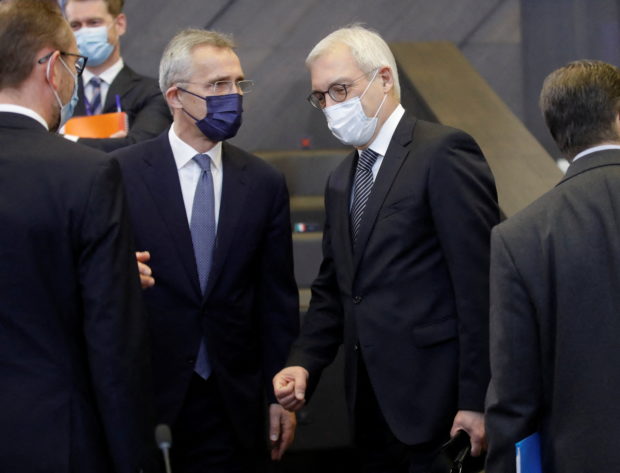NATO head says differences with Russia will be hard to bridge

NATO Secretary-General Jens Stoltenberg chats with Russian Deputy Foreign Minister Alexander Grushko ahead of NATO-Russia Council at the Alliance’s headquarters in Brussels, Belgium January 12, 2022. Olivier Hoslet/Pool via REUTERS
BRUSSELS — The differences between Russia and NATO over Ukraine will be difficult to bridge, the head of the Atlantic alliance said Wednesday after four hours of talks where Moscow pressed its demands for security guarantees from the West.
“There are significant differences between NATO allies and Russia,” NATO Secretary-General Jens Stoltenberg told reporters.
“Our differences will not be easy to bridge, but it is a positive sign that all NATO allies and Russia sat down around the same table and engaged on substantive topics.”
Russia has forced the West to the negotiating table by massing some 100,000 troops near the border with Ukraine, a former Soviet republic that aspires to join NATO.
It denies planning to invade but says it needs a series of guarantees for its own security, including a halt to any further NATO expansion and a withdrawal of alliance forces from central and eastern European nations that joined it after the Cold War.
Article continues after this advertisementHigh price
Stoltenberg said any use of Russian force against Ukraine would be a serious political mistake for which Russia would pay a high price.
Article continues after this advertisementHe reiterated NATO’s position that only Ukraine and NATO can decide whether it becomes a member.
However, Stoltenberg said NATO was ready for further talks with Moscow on issues including arms control and missile deployments. Russia had asked for time to come back with an answer on this, he added.
Russian Deputy Foreign Minister Alexander Grushko, who headed Moscow’s delegation, was due to brief reporters later.
Stoltenberg’s remarks made clear there had been no breakthrough at the talks, which came two days after Russian and U.S. diplomats met in Geneva and reported no narrowing of their differences.
Russia has accused the West of failing to appreciate the urgency of its demands and said it is not prepared to allow negotiations to drag on indefinitely.
It says NATO’s expansion from 16 members at the end of the Cold War to 30 now – including a large group of ex-communist states in central and eastern Europe – poses a threat to its security and it needs to draw “red lines” now to protect itself.